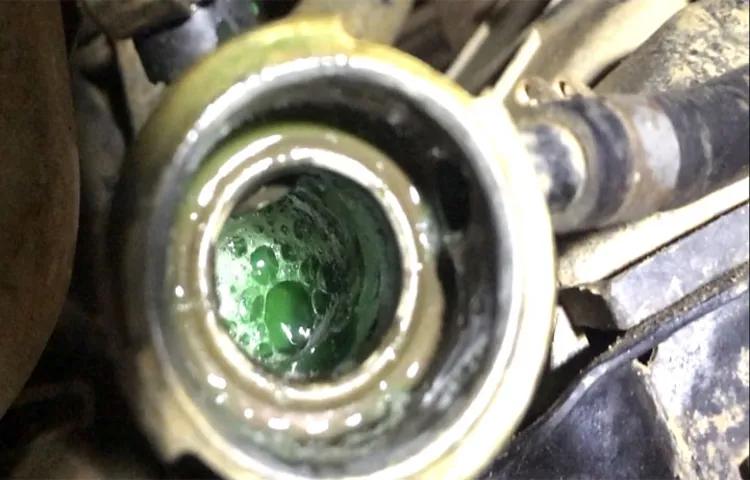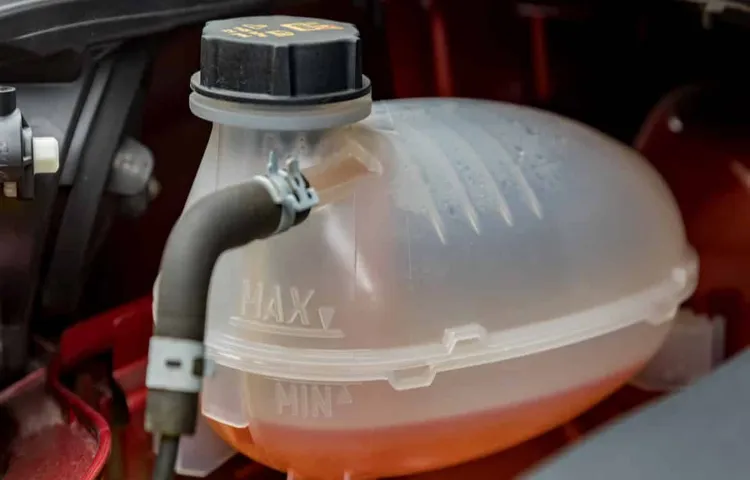Are you constantly finding bubbles in your car’s coolant system, making you wonder what could be causing it? Bubbling coolant can be an indicator of several issues within your vehicle, ranging from minor to severe. However, it’s essential to address the problem quickly before it causes further damage to your car and puts your safety at risk. In this blog, we’ll explore the causes of coolant bubbling and provide practical solutions to help you fix the issue and keep it from happening again.
So, buckle up and get ready to learn how to tackle the bubbling coolant problem in your vehicle!
Table of Contents
Understanding Bubbling Coolant
If you notice bubbling coolant in your vehicle, it could be a sign of a bigger problem. Bubbling coolant occurs when air pockets get trapped in your cooling system and create bubbles that rise to the surface. These bubbles can prevent coolant from flowing properly, leading to overheating and engine damage.
There are several reasons why your coolant may be bubbling, such as a blown head gasket, a cracked cylinder head, or a faulty radiator cap. Before trying to fix the issue yourself, it’s important to diagnose the root cause of the bubbling coolant. It may be best to take your vehicle to a trusted mechanic who can properly inspect and diagnose the problem.
Neglecting a bubbling coolant issue can cause significant damage to your engine. So, it’s best to address the problem immediately and avoid costly repairs down the road.
Definition and Causes
Bubbling coolant is a common indication that there’s a problem with your vehicle’s cooling system. This is often caused by excessive heat, resulting in air pockets forming within the coolant. These air pockets, in turn, cause the coolant to bubble and overflow, which can result in engine damage if not addressed immediately.
The reasons for excessive heat can vary, but the most common causes include a malfunctioning thermostat, a damaged radiator, or a broken water pump. If you notice bubbling coolant, it’s important to get your vehicle checked out right away to prevent any potential damage to your engine. Remember, preventative maintenance is always the best approach when it comes to keeping your vehicle running smoothly.

Signs of Bubbling Coolant
Bubbling coolant is a sign of potential trouble if you own a car. When coolant is bubbling, it means that the coolant is boiling and releasing pressure that may lead to engine damage. The most common reason for coolant to bubble is due to a failed head gasket or a cracked engine block.
These issues can cause bubbles to form, which can lead to bubbles overflowing into the coolant reservoir or even the radiator. Another reason why coolant can bubble is due to overheating caused by a malfunctioning radiator fan or a blocked cooling system. All these issues can cause serious damage if not inspected and addressed by a professional mechanic.
If you notice a bubbling coolant, it’s advisable to have your car inspected immediately. A well-maintained cooling system is critical to the engine’s life, and early detection of issues can save you from costly repairs. So, stay alert and keep your eye on your car’s coolant levels by checking them regularly.
Diagnosing the Problem
If you’re experiencing bubbling coolant, it may be a sign of a bigger issue with your vehicle’s cooling system. One potential culprit could be a cracked or damaged head gasket, which allows air to escape into the coolant system and create an air pocket, resulting in bubbling and overheating. Other common causes could include a clogged radiator, damaged water pump, or a malfunctioning thermostat.
To diagnose the problem, you’ll need to inspect the cooling system and look for signs of damage or wear. If you’re not comfortable doing this on your own, it’s best to take your vehicle to a certified mechanic who can properly diagnose the issue and perform any necessary repairs. Ignoring bubbling coolant can result in serious engine damage, so it’s important to address the issue as soon as possible.
Don’t let a seemingly small problem turn into a major headache – get it fixed ASAP.
Visual Inspection and Tests
When it comes to diagnosing a problem in a system or machine, visual inspection and tests are key. These steps allow you to physically examine the components and identify any potential issues. For example, taking a close look at the wiring or hoses can give you an indication if there is any damage or wear and tear.
Additionally, running tests such as voltage or pressure checks can help you pinpoint where a problem may be occurring. By taking the time to perform these actions, you can save time, money, and potential damage down the line. So next time you’re faced with a problem, don’t forget to put your eyes and testing equipment to good use.
Common Issues Found
When it comes to diagnosing common issues found with anything, it can be a process of trial and error. However, there are a few helpful tips and tricks that can make the process easier. First, it’s important to gather as much information as possible about the issue.
This can include when it started, any patterns or triggers that were noticed, and any other relevant details. From there, it’s often helpful to brainstorm potential causes and systematically rule them out one by one until the issue is identified. Additionally, it can be helpful to consult with experts or seek out resources that may provide insight into similar issues.
Overall, the key to diagnosing common issues is to approach it with a curious and open mindset, and to be willing to put in the time and effort to thoroughly investigate possible causes.
Solutions for Bubbling Coolant
Are you experiencing bubbling coolant in your vehicle and wondering how to fix it? This issue can be caused by various reasons such as a blown head gasket, a cracked cylinder head, or a malfunctioning water pump. To remedy this problem, check for visible leaks or cracks in the hoses and the radiator, and replace as necessary. Make sure the radiator cap is functioning correctly and always use the recommended coolant for your vehicle.
If none of these solutions work, consider seeking the help of a professional mechanic who is specialized in diagnosing cooling system problems. Fixing bubbling coolant is crucial for maintaining your vehicle’s health and avoiding any potential overheating problems that can lead to severe engine damage.
Fixing Minor Leaks
If you’ve noticed bubbling coolant in your vehicle, there could be a few different causes. One possibility is a minor leak that’s allowing air into the system. This can lead to bubbles and an overheating engine.
Luckily, fixing minor leaks is typically a straightforward process. You may want to start by checking your hoses and connections for signs of damage or wear. If you spot any issues, replacing these parts could solve the problem.
Alternatively, you might need to tighten up a loose clamp or fitting. It’s also worth inspecting your radiator cap for damage, as this can sometimes cause bubbling coolant. If none of these solutions work, you may want to have a professional diagnose and repair the issue.
By taking care of minor leaks promptly, you’ll be able to avoid more serious engine damage down the line, keeping your vehicle running smoothly for years to come.
Flushing and Refilling the Coolant System
If you’ve been experiencing bubbling coolant, there are a few solutions to consider. One thing you can do is flush and refill your coolant system, which is crucial to maintaining your engine’s temperature and preventing overheating. Over time, dirt and debris can accumulate in the system and cause blockages, leading to bubbling and other issues.
Flushing the system helps to clear out any buildup and ensure that coolant can flow freely through the system. Refilling with fresh coolant also helps to keep your engine running smoothly. It’s important to use the correct type of coolant for your vehicle, as different types have different boiling points and other properties.
If you’re not sure what type to use, consult your owner’s manual or a mechanic. By taking these steps, you can help prevent bubbling coolant and keep your engine in good condition.
Replacing the Head Gasket
Replacing the head gasket is a crucial process that may be necessary if you’re experiencing bubbling coolant in your vehicle. Essentially, a head gasket is responsible for keeping the engine oil and coolant systems apart. When it fails, oil and coolant can mix and lead to engine damage.
A bubbling coolant may indicate that the head gasket is damaged and requires replacement. However, it’s essential to ensure that there aren’t any other underlying issues that could be causing the problem. Replacing the head gasket can be a complex and time-consuming process, but it’s necessary to ensure that your engine doesn’t experience any long-term damage.
If you ignore this issue, it could lead to severe engine damage and costly repairs. Therefore, it’s crucial to seek the help of a professional mechanic to ensure the problem is correctly diagnosed and repaired. Replacing the head gasket will help to prevent future engine issues and prolong your vehicle’s overall lifespan.
Conclusion
In conclusion, fixing bubbling coolant is not rocket science, but it does require some mechanical know-how. Most often, air pockets, a blown head gasket, or a damaged radiator cap are the main culprits. Don’t let that bubbly coolant ruin your day – get under the hood and fix the issue before it turns into a real headache.
And remember, if all else fails, call your local mechanic for some witty and clever assistance!”
FAQs
What causes coolant to bubble in the radiator?
Coolant can bubble in the radiator due to a variety of reasons, such as a blown head gasket, cracked engine block, or damaged radiator cap. It’s best to have a mechanic diagnose the issue to determine the root cause and fix it promptly.
How do I check if my radiator cap is causing coolant to bubble?
You can check your radiator cap by inspecting it for any signs of damage, such as cracks or breaks. You can also perform a pressure test on the cap to ensure it’s maintaining the proper pressure. If the cap is damaged, it should be replaced promptly to prevent any further coolant bubbling.
Can adding too much coolant cause bubbling?
Yes, adding too much coolant can cause bubbling in the radiator due to excess pressure buildup. It’s important to follow the manufacturer’s recommended coolant levels and refill as needed. If you suspect you’ve overfilled your coolant, have a mechanic check it out.
Is a bubbling coolant system always a sign of a serious issue?
While bubbling coolant can be a sign of serious issues like a blown head gasket, it can also be caused by something as simple as a damaged radiator cap. However, it’s important to have a mechanic diagnose the issue to ensure it’s properly fixed and prevent any further damage.
Can I drive my car if the coolant is bubbling?
It’s best to avoid driving your car if you notice bubbling coolant, as it can lead to engine damage and potentially cause a breakdown. Have a mechanic diagnose and fix the issue promptly to ensure your car is safe to drive.
How do I prevent coolant from bubbling in the future?
Routine maintenance, such as regular coolant flushes and inspections, can help prevent coolant from bubbling. Additionally, following the manufacturer’s recommended coolant levels and addressing any issues promptly can help prevent further problems.
Is it safe to fix bubbling coolant myself?
Fixing bubbling coolant can be a complex issue, and it’s not recommended to attempt it yourself unless you have experience with car repairs. It’s best to have a mechanic diagnose and fix the issue to ensure it’s properly handled.


